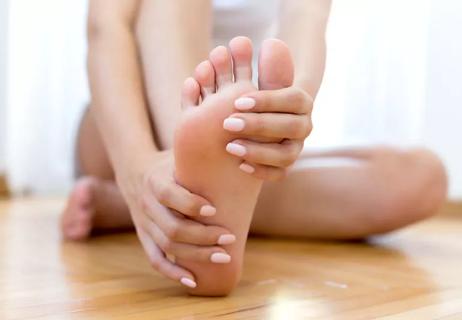These home treatments can help

If you’re dealing with chronic heel pain, one likely culprit is plantar fasciitis. It’s a common foot injury that can cause a stabbing pain in the bottom of your foot near the heel. It sometimes resolves on its own, but there are a few simple home treatments that also can help.
Advertisement
Cleveland Clinic is a non-profit academic medical center. Advertising on our site helps support our mission. We do not endorse non-Cleveland Clinic products or services. Policy
The plantar fascia is a band of deep tissue that runs from your heel bone to your toes. Plantar fasciitis is a deformation or a tear of that tissue. It causes irritation, inflammation, and, eventually, pain.
Sports chiropractor Thomas Torzok, DC, says the problem typically develops over time. It also can take some time to heal — anywhere from months to a year, he says.
“The plantar fascia is not a tissue with great blood supply or high metabolic activity,” he notes. “It probably takes years for plantar fasciitis to form to the point where you start to notice it. And, as a result, it takes some time for it to heal. Once it’s irritated, it’s pretty stubborn.”
Despite this, he says there are some simple things you can do at home to combat the problem. But first, you need to understand why it’s happening.
Plantar fasciitis is often an overuse injury, typically from sports-related activities that involve running or jumping. “It also may trace back to abnormal foot mechanics or poor footwear choices,” Dr. Torzok explains.
“Usually, you’ll feel pain upon initial weight-bearing in the bottom of your foot,” he says. “Sometimes that will occur first thing in the morning when you wake up.”
Other factors that can increase your risk of developing plantar fasciitis include:
Advertisement
Simple home treatments can often resolve plantar fasciitis, especially if you catch it early. But it may take longer to heal if it has worsened over time.
“Plantar fasciitis may go away after you stretch your foot out and walk around for a while,” Dr. Torzok says. “But for some people, prolonged standing or sitting may aggravate it again. It’s bearing the entire amount of your body weight, and that can lead to delayed recovery.”
Try these tips for relief:
The pain and discomfort that comes with plantar fasciitis can be so frustrating that you’d probably try anything to get rid of it, but Dr. Torzok wants you to know that certain remedies will only exacerbate the problem.
If you have heel pain, do not:
If home treatment isn’t working, get help, Dr. Torzok says. Your doctor can make sure the pain you’re feeling is from plantar fasciitis — and further advise you if it isn’t.
“That’s the tricky thing because other factors can cause pain in the bottom of your feet,” he says. “So if you’re still in pain after working on relieving it for a few days, call your doctor.”
Advertisement
Advertisement
Learn more about our editorial process.
Advertisement

Treat your feet to easing stretches

Certain populations are more at risk for severe illness

How coronavirus can affect your heart and what you can do to protect it

Heel spurs aren’t the only culprit when it hurts to walk

The flu, RSV, COVID-19, pneumonia and more typically circulate during cold weather months. I added this change

Simple swaps improve a comfort food staple.

Type 2 diabetes isn’t inevitable with these dietary changes

Applying a hot or cold compress can help with pain